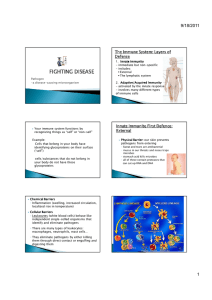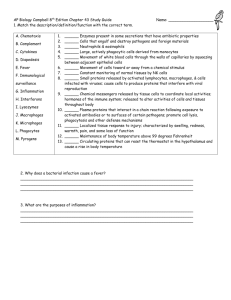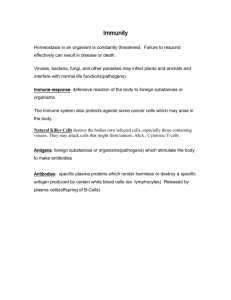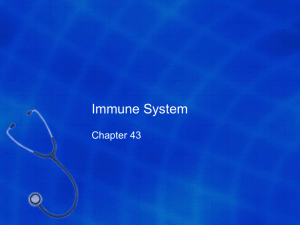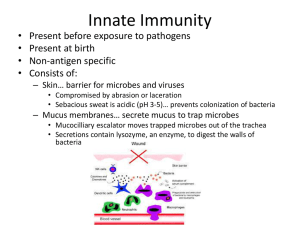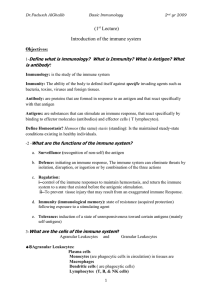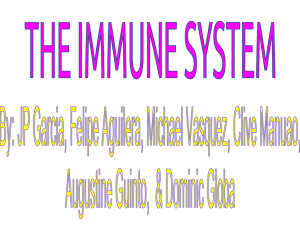Immunology first semster
advertisement
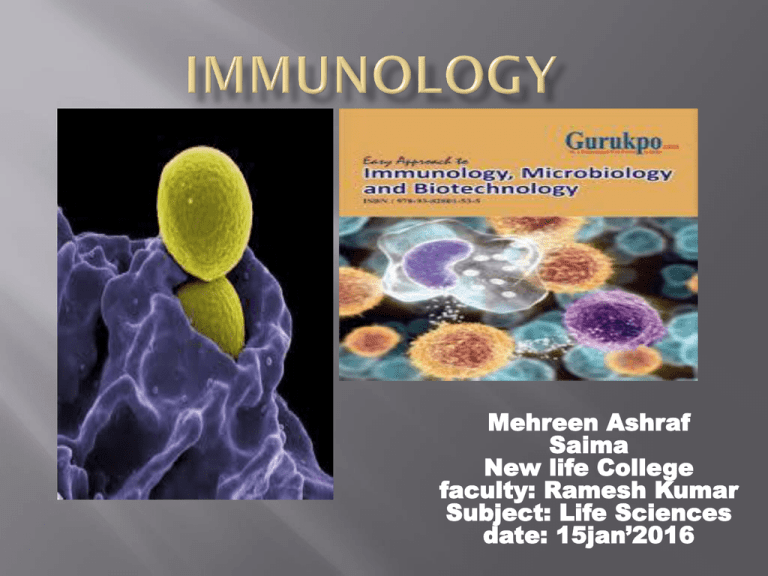
Mehreen Ashraf Saima New life College faculty: Ramesh Kumar Subject: Life Sciences date: 15jan’2016 History and impact The types and functions of cells in the immune system. How cells communicate and recognize antigen Structure and functions Active and Passive Immunity Anything that causes an immune response is called an antigen. An antigen may be harmless, such as grass pollen, or harmful, such as the flu virus. Disease-causing antigens are called pathogens. The immune system is designed to protect the body from pathogens. In humans, the immune system begins to develop in the embryo. The immune system starts with hematopoietic (from Greek, "bloodmaking") stem cells. These stem cells differentiate into the major players in the immune system (granulocytes, monocytes, and lymphocytes). These stems cells also differentiate into cells in the blood that are not involved in immune function, such as erythrocytes (red blood cells) and megakaryocytes (for blood clotting). Stem cells continue to be produced and differentiate throughout your lifetime. The word “Immuis” means free from burden and “immunitas” means exemption from government taxes and this provided the English terminology Immunity. Immunity is a broad definition: This is a protective or defense mechanism of our body, which leads us to a healthy life. Inborn or innate immunity: It is present at birth; This is our First Line Of Defense. Acquired or specific: It is not present at birth but becomes part of our immune system as the lymphoid system develops. 1970: WHO defined immunity as immune response to antigen ( Foreign body) in form of Humoral ( activation of B-lymhocytes) Cellular (by activation of T-lymphocytes Macrophages B cells T cells Factor Mode Of Action -Keratin layer of intact skin -Acts as mechanical barrier -Lysozyme in tears and other secretions -Degrades peptidoglycan in bacteria cell wall -Respiratory cilia -Elevate mucus containing trapped organisms -Low pH in stomach and vagina; -Retards growth of microbes fatty acids in skin -Surface phagocytes -Ingest and destroy microbes (eg. alveolar macrophages) -Defensins (cationic peptides) -Create pores in microbial membrane -Normal flora of throat, colon -Occupy receptors which prevent and vagina colonization by pathogens Kill virus infected cells Ingest and destroy microbes Ingest and destroy microbes, and present antigen to helper T-cells Inhibit viral replication C3b is an opsonin, membrane attack complex creates holes in bacterial membranes Sequester iron required for bacterial growth Elevated temperature retards bacterial growth Limits spread of microbes Causes hypermutation in retroviral DNA and mRNA Neutrophils Macrophages and dendritic cells Inferons Complement Active immunity is resistance acquired after contact with foreign antigens, eg, microorganisims This contact may consist of : Clinical or subclinical infections Immunization with live or killed infectious agents or their antigens. Exposure to microbial products (eg, toxins and toxoids) Passive immunity is resistance based on antibodies preformed in another host. Other forms of passive immunity are IgG passed from the mother to the fetus during pregnancy. IgA passed from the mother to the newborn during breast feeding. Passive-active immunity involves giving both preformed antibodies (immune globulins) to provide immediate protection and Vaccine to provide long term protection These preparations should be given at different sites in the body to prevent the antibodies from neutralizing the immunogen in the vaccine. This approach is used in the prevention of Tetanus, Rabies and Hepatitis B https://en.wikibooks.org/wiki/Immunology/ Introduction http://www.powershow.com/view/11d062ZDRmN/Introduction_to_Immunology_power point_ppt_presentation http://www.biology.arizona.edu/immunolog y/tutorials/immunology/page2.html


